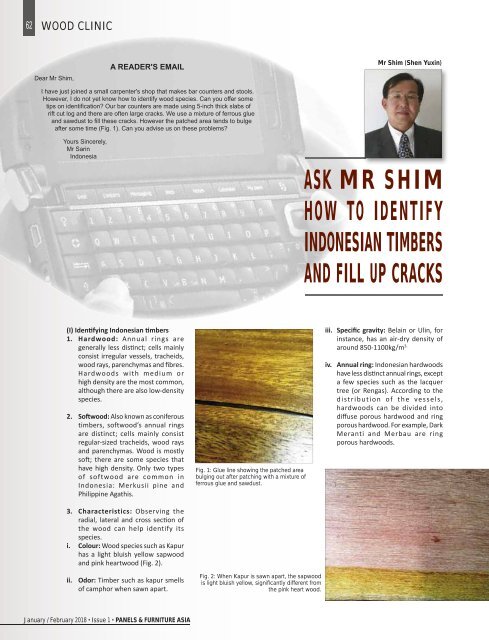Panels & Furniture Asia January/February 2018
Panels & Furniture Asia (PFA) is a leading regional trade magazine dedicated to the woodbased panel, furniture and flooring processing industry. Published bi-monthly since 2000, PFA delivers authentic journalism to cover the latest news, technology, machinery, projects, products and trade events throughout the sector. With a hardcopy and digital readership comprising manufacturers, designers and specifiers, among others, PFA is the platform of choice for connecting brands across the global woodworking landscape.
Panels & Furniture Asia (PFA) is a leading regional trade magazine dedicated to the woodbased panel, furniture and flooring processing industry. Published bi-monthly since 2000, PFA delivers authentic journalism to cover the latest news, technology, machinery, projects, products and trade events throughout the sector. With a hardcopy and digital readership comprising manufacturers, designers and specifiers, among others, PFA is the platform of choice for connecting brands across the global woodworking landscape.
Create successful ePaper yourself
Turn your PDF publications into a flip-book with our unique Google optimized e-Paper software.
62 WOOD CLINIC<br />
Dear Mr Shim,<br />
A READER'S EMAIL<br />
Mr Shim (Shen Yuxin)<br />
I have just joined a small carpenter's shop that makes bar counters and stools.<br />
However, I do not yet know how to identify wood species. Can you offer some<br />
tips on identification? Our bar counters are made using 5-inch thick slabs of<br />
rift cut log and there are often large cracks. We use a mixture of ferrous glue<br />
and sawdust to fi ll these cracks. However the patched area tends to bulge<br />
after some time (Fig. 1). Can you advise us on these problems?<br />
Yours Sincerely,<br />
Mr Sarin<br />
Indonesia<br />
ASK MR SHIM<br />
HOW TO IDENTIFY<br />
INDONESIAN TIMBERS<br />
AND FILL UP CRACKS<br />
(I) Idenfying Indonesian mbers<br />
1. Hardwood: Annual rings are<br />
generally less distinct; cells mainly<br />
consist irregular vessels, tracheids,<br />
wood rays, parenchymas and fibres.<br />
Hardwoods with medium or<br />
high density are the most common,<br />
although there are also low-density<br />
species.<br />
2. Sowood: Also known as coniferous<br />
timbers, softwood’s annual rings<br />
are distinct; cells mainly consist<br />
regular-sized tracheids, wood rays<br />
and parenchymas. Wood is mostly<br />
soft; there are some species that<br />
have high density. Only two types<br />
of softwood are common in<br />
Indonesia: Merkusii pine and<br />
Philippine Agathis.<br />
3. Characteristics: Observing the<br />
radial, lateral and cross section of<br />
the wood can help identify its<br />
species.<br />
i. Colour: Wood species such as Kapur<br />
has a light bluish yellow sapwood<br />
and pink heartwood (Fig. 2).<br />
ii. Odor: Timber such as kapur smells<br />
of camphor when sawn apart.<br />
Fig. 1: Glue line showing the patched area<br />
bulging out after patching with a mixture of<br />
ferrous glue and sawdust.<br />
Fig. 2: When Kapur is sawn apart, the sapwood<br />
is light bluish yellow, significantly different from<br />
the pink heart wood.<br />
iii. Specific gravity: Belain or Ulin, for<br />
instance, has an air-dry density of<br />
around 850-1100kg/m 3.<br />
iv. Annual ring: Indonesian hardwoods<br />
have less distinct annual rings, except<br />
a few species such as the lacquer<br />
tree (or Rengas). According to the<br />
distribution of the vessels,<br />
hardwoods can be divided into<br />
diffuse porous hardwood and ring<br />
porous hardwood. For example, Dark<br />
Meranti and Merbau are ring<br />
porous hardwoods.<br />
<strong>January</strong> / <strong>February</strong> <strong>2018</strong> • Issue 1 • PANELS & FURNITURE ASIA


















